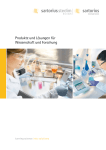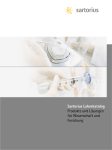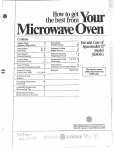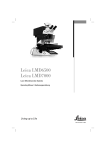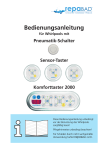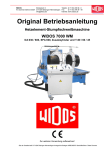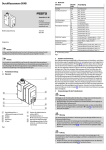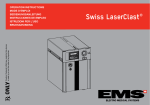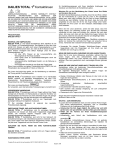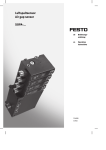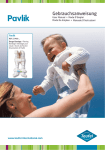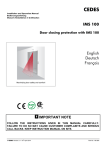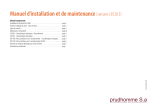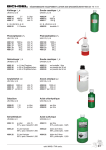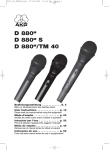Download Incubator XL-3_PeCon_18.01.2008
Transcript
°C Manual Incubator XL-3 CO2 °C Heating Unit CO2-Controller Tempcontrol 37-2 digital CO2-Cover tempcont rol 37-2 digital 37.0 °C 37.0 + + on 1 E 2 power + + of f CTI-Controll er 3700 heater nom 5.0 2 real co ntr ol CO 2 % setpoint 2 normal overheat ventilation heating speed intensity dis play CO 2 reducing valve valve on remote power off Stabilization of the “in vitro environment” for cell and tissue culture 37 °C Laminar air flow 5 .0 % CO 2 7.0 % O2 German – English www.pecon.biz Diese Bedienungsanleitung gehört zu diesem Produkt. Sie enthält wichtige Hinweise zur Inbetriebnahme und zur Handhabung. Machen Sie sich daher bitte mit dem Inhalt vertraut und beachten Sie besonders die Hinweise, die der sicheren Bedienung des Gerätes dienen. Achten Sie hierauf, auch wenn Sie dieses Produkt an Dritte weitergeben. Heben Sie deshalb diese Bedienungsanleitung zum Nachlesen auf! Änderungen, die dem technischen Fortschritt dienen, bleiben vorbehalten. Das Manual unterliegt keinem "Update-Service". Solange keine ausdrückliche Genehmigung vorliegt, ist die Weitergabe und Vervielfältigung dieses Dokuments und die Benutzung und Verbreitung seiner Inhalte nicht gestattet. Verstöße verpflichten zur Zahlung von Entschädigung. Alle Rechte vorbehalten, die im Falle der Gewährung von Patenten und Gebrauchsmustern entstehen. Alle in diesem Handbuch erwähnten Produktnamen können Warenzeichen oder eingetragene Warenzeichen der jeweiligen Eigentümer sein und sind nicht überall ausdrücklich durch "TM" und "®" gekennzeichnet. © 2005 These operating instructions form an integral part of this product. It contains important information on installing and using the product. Please keep this in mind, especially when passing this product on to third parties. For this reason, keep the operationg instructions for future reference! Design and specifications are subject to change without notice. The manual is not covered by an update service. Unless expressly authorized, forwarding and duplication of this document, and the utilization and communication of its contents are not permitted. Violations will entail an obligation to pay compensation. All rights reserved in the event of granting of patents or registration of a utility model. All product names mentioned herein may be the trademarks or registered trademarks of their respective companies and "TM" and "®" are not mentioned in each case in this manual. © 2005 Inkubator XL-3 PeCon # 0431.400 Passend für: Zeiss # 000000-1272-122 Zeiss Axiovert 200 + 200M kompatibel mit ApoTome Inhaltsverzeichnis Kurzbeschreibung .................................................................................................................................... 1 Lieferumfang ........................................................................................................................................... 2 Bestimmungsgemäßer Einsatz ................................................................................................................ 2 Sicherheits- und Gefahrenhinweise ......................................................................................................... 2 Bedienelemente...................................................................................................................................... 3 Montage.................................................................................................................................................. 4 Inbetriebnahme....................................................................................................................................... 7 Hinweise................................................................................................................................................... 8 Wartung und Reinigung........................................................................................................................... 8 Fehlersuche ............................................................................................................................................. 9 Technische Daten.................................................................................................................................. 10 Kurzbeschreibung • Leichte und schnelle Montage. Kein Werkzeug erforderlich. • Große Scharniertüren links und rechts in der Vorderfront, darunter befinden sich Öffnungen mit 3 Schiebetüren. • Durchgang für Kabel und Schläuche links und rechts in der Rückwand (Schiebetüren mit Arretierung). Bodeneinschübe, links und rechts, mit Aussparungen für Objektführer (Koaxialtrieb) und Silikonabdichtung. Rechts befindet sich eine Öffnung für einen Lichtleiter (Poly V Faser). • Kompatibel zu allen Kondensoren. Mikromanipulatoren verschiedener Hersteller einsetzbar (z.B. Eppendorf, Narishige). Das ApoTome kann auch bei montiertem Inkubator aus- und eingebaut werden. • Homogene Warmluftverteilung durch zentrale Luftzufuhr von hinten. • Zum Betrieb wird eine weitere heizbare Komponente (z.B. Heizeinsatz P, Heizbarer Mikroskoptisch) empfohlen. Für Spezialanwendungen (z.B. Multischalen mit Glasboden) kann der Inkubator XL-3 nur mit der Heating Unit betrieben werden. • Eine lokale CO2-Inkubation kann durch Verwendung des CO2-Controllers in Kombination mit passenden CO2-Deckeln durchgeführt werden. Vorderansicht Rückansicht 24.11.2005 www.pecon.biz 2 Manual: Inkubator XL-3 Lieferumfang Anzahl Artikel-Nr. Temperatursensor-Verbindungskabel 1 # 0427.001 Temperatursensor mit Kabel + Klett-Befestigungspunkte 1 # 0431.101 Luftführungsschlauch-Set Kabelhalter, selbstklebend (4 Stck.) 1 1 # 0431.207 # 0431.204 Bedienungsanleitung 1 Ersatzteile: Klett-Befestigungspunkte (6 Stck.) 1 # 0431.104 Steckermodul für Temperatursensor 1 # 0431.106 Rändelschraube, schwarz, M8x20 1 # 0431.414 Einschubboden, links 1 # 0431.102 Einschubboden, rechts - ApoTome 1 # 0431.403 Lampenträgerabdichtung, links Lampenträgerabdichtung, rechts 1 1 # 0431.410 # 0431.411 Rändelschraube, schwarz, M6x10 2 # 0431.413 Schiebetüre mit 4 Durchgängen 1 # 0431.110 Knopf mit Schraube, blau 1 # 0431.111 Bestimmungsgemäßer Einsatz • Dieser Inkubator dient der Schaffung eines gleichmäßig erwärmten Luftbereiches um den Mikroskoptisch, der den Kondensor, den Objektivkranz und auch Mikromanipulatoren einschließt. • Zur Versorgung des Inkubators mit Warmluft ist die Heating Unit in Kombination mit dem Tempcontrol 37-2 digital zu verwenden. • Das Material des Inkubators ist für die üblichen Inkubationstemperaturen von Zell- und Gewebekulturen ausgelegt (typisch 37°C; max. 50°C). • Eine Erhöhung der Luftfeuchte, sowie der CO2-Konzentration im gesamten Inkubatorinnenraum ist nicht zulässig. Zur Kontrolle dieser Parameter innerhalb dieses Inkubators stehen lokale Lösungen zur Verfügung. Eine andere Verwendung als zuvor beschrieben kann zur Beschädigung dieses Produktes und weiteren, damit verwendeten Komponenten, führen. Außerdem ist dies mit Gefahren wie z.B. Kurzschluss, Brand, elektrischer Schlag etc. verbunden. Das gesamte Produkt darf nicht geändert bzw. umgebaut werden! Die Sicherheitshinweise sind unbedingt zu beachten! Bei nicht bestimmungsgemäßem Betrieb gehen sämtliche Garantieansprüche verloren. Der Hersteller haftet nicht für Schäden, die sich aus dem nicht bestimmungsgemäßen Betrieb des Geräts ergeben. Weiterhin haftet der Hersteller nicht für Folgeschäden, es sei denn, es wird Vorsatz oder grobe Fahrlässigkeit nachgewiesen. Sicherheits- und Gefahrenhinweise = Hinweise, die der Sicherheit des Benutzers, sowie zur Vermeidung der Beschädigung des Gerätes dienen. Lesen Sie die Gebrauchsanweisung! = Hinweise, die für einen problemlosen Betrieb unbedingt beachtet werden müssen! www.pecon.biz 24.11.2005 3 Manual: Inkubator XL-3 • Der scharfkantige Federstahl des flexiblen Warmluftschlauches kann unter Umständen an den Schlauchenden hervortreten. • Bei Verwendung des Inkubators zusammen mit einer lokalen CO2-Begasung ist auf eine ausreichende Belüftung des Raumes zu achten, um die Akkumulation einer schädlichen CO2Konzentration (ab ca. 0,5 Vol-%) zu verhindern. • Wenn anzunehmen ist, dass ein gefahrloser Betrieb nicht mehr möglich ist, so ist das Gerät außer Betrieb zu setzen und gegen unbeabsichtigten Betrieb zu sichern. Es ist anzunehmen, dass ein gefahrloser Betrieb nicht mehr möglich ist, wenn: - das Gerät sichtbare Beschädigungen aufweist; - Nach längerer Lagerung unter ungünstigen Verhältnissen oder nach schweren Transportbeanspruchungen. - • Beachten Sie auch die Sicherheitshinweise in den einzelnen Kapiteln bzw. in den Bedienungsanleitungen der angeschlossenen Geräte. Bedienelemente 1 2 3 4 5 6 14 7 9 10 13 12 11 (1) Griff zum Öffnen der linken Lampenträgerabdichtung (2) Feststellknopf für linke Lampenträgerabdichtung (3) Linke Lampenträgerabdichtung (4) Rechte Lampenträgerabdichtung (5) Feststellknopf für rechte Lampenträgerabdichtung (6) Griff zum Öffnen der rechten Lampenträgerabdichtung (7) Rechte obere Scharniertüre – Zugang zum Mikroskoptisch und Kondensor (8) Arretierung für Einschubboden, rechts (9) Durchgang für Lichtleiterfaser (10) Einschubboden, rechts - ApoTome (11) Rechte untere Schiebetüren – Zugang zu Objektiven, Filtern und ApoTome (12) Linke untere Schiebetüre – Zugang zu Objektiven und Filtern (13) Einschubboden, links (14) Linke obere Scharniertüre – Zugang zum Mikroskoptisch und Kondensor 24.11.2005 www.pecon.biz 4 Manual: Inkubator XL-3 15 16 17 18 (15) Rechte hintere Schiebetüre – Durchgang für Kabel und Schläuche (16) Anschluss für Luftführungsschlauch (Warmluft) (17) Steckermodul für Temperatursensor (18) Linke hintere Schiebetüre – Durchgang für Kabel und Schläuche Montage Anschlussschema Luftstrom Verbindungskabel (für Sensor) Verbindungskabel (für Geräte) Heating Unit Tempcontrol 37-2 digital tempcontrol 37-2 digital 37.0 °C 37.0 + + on power Sensorkabel + off 1 E 2 + Axiovert 200 Beobachtungsbereich TemperaturHeizbarer Mikroskoptisch sensor Kabel Heizbarer Mikroskoptisch Scanningtisch Mechanischer Kreuztisch www.pecon.biz 24.11.2005 5 Manual: Inkubator XL-3 Beschreibung Lampenträgerabdichtung öffnen Befestigungsknopf Befestigungsknopf Warmluft Zufuhr Bodeneinschübe (rechts und links) Steckermodul (Sensorkabel) Schiebtüren Durchgang für Kabel, Schläuche • Klebebänder (Transportsicherung) vom Inkubator entfernen und beide Bodeneinschübe (10) und (13) seitlich herausziehen. Der linke Boden muss dazu innen zuerst leicht nach oben gekippt werden, damit er aus den Arretierstiften rutscht, der rechte vorher entriegelt werden (8). Die rot gekennzeichneten Transportsicherungsstopfen entfernen. • Heizbaren Mikroskoptisch mit Objektführer, mechanischen Kreuztisch oder Scanningtisch mit Heizeinsatz P oder Heizeinsätzen M06-96 montieren, ebenso Kondensor und Objektive befestigen, gegebenenfalls Mikromanipulatoren anbringen. • Kabel und Schläuche der Komponenten rechts und links vom Mikroskop auf den Tisch legen. Endabschalter (y-Achse) des Scanningtisches so einstellen, dass der bewegliche Teil nicht nach vorn über die Tischbegrenzung hinausfährt (Auflagefläche für Inkubator XL-3). • Vor Aufsetzen des Inkubators auf das Mikroskop muss der Lampenträger eingeschwenkt und der vordere Haltegriff (zwischen Tubus und Mikroskoptisch) mit einem Inbusschlüssel entfernt werden. • Die Lampenträgerabdichtungen (3) und (4) oben auf dem Inkubator vollständig öffnen: Dazu Drehknöpfe (2) und (5) öffnen und beide Schieber an den Griffen (1) und (6) nach rechts bzw. links schieben. • Inkubator XL-3 (ohne Bodeneinschübe) vorsichtig von oben über das Mikroskop führen und positionieren. Vorne muss der Inkubator XL-3 zwischen Okulartubus und Mikroskoptisch aufliegen (Abb. 1), die hintere Auflage sitzt in richtiger Position auf dem trapezförmigen Teil des Mikroskopstativs (Abb. 2). Abb. 1: Korrekte vordere Inkubatorposition. 24.11.2005 Abb. 2: Korrekte hintere Inkubatorposition. www.pecon.biz 6 Manual: Inkubator XL-3 • Die oberen Abdichtungsschieber am Lampenträger schließen. Darauf achten, dass das Lampenkabel durch die dafür vorgesehene Öffnung in der Silikonplatte läuft (Abb. 3). Die richtige Platzierung des Kabels in der Silikonplatte unten am Lampenkabelausgang ebenfalls überprüfen. • Ein eventuell am Lampengehäuse (CZ# 447219-0000-000) angebrachter Streulichtschutz muss entfernt werden, da sich anderenfalls die Abdichtungsschieber nicht schließen lassen. • Durch die hinteren Schiebetüren (15) und (18) werden die Kabel bzw. Schläuche nach außen geführt. In der obersten Position werden die Türen automatisch fixiert. • Temperatursensor von innen an das hintere Steckermodul (17) anschließen. Durch Drehen mit leichtem Druck rutscht der Kabelstecker (5 pol.) leicht in die richtige Position und kann durch Rechtsdrehung gesichert werden. • Den Sensor mit einem Klettpunkt befestigen (siehe unbedingt Abschnitt "Sensorposition", Seite 7). Das Sensorkabel so führen, dass es nicht zwischen beweglichen Teilen (z.B. Scanningtisch) eingeklemmt werden kann. Kabel eventuell mit Kabelhaltern befestigen. • Rechten und linken Bodeneinschub einsetzen. Der linke Bodeneinschub (13) rastet in Endposition in kurze Stifte ein. Der rechte Einschub (10) wird durch einen blauen Verschluss (8) arretiert. Bei der Montage muss beachtet werden, dass die Führungsstangen vom Objektführer bzw. mechanischem Kreuztisch genau in die Bahnen (mit Silikonplatte abgedichtet) der Bodeneinschübe geführt werden. • Heating Unit rechts oder links hinter den Inkubator stellen und mit dem Luftführungsschlauch an den Inkubator XL-3 anschließen. Dazu den Schlauch zuerst mit dem Plexiglasadapter auf die hintere Luftzufuhr (16) stecken und mit der schwarzen M8 Kunststoffschraube sichern. Danach den Schlauch mit dem Adapter auf den oberen Luftausgang der Heating Unit stecken. • Zur Entkopplung von eventuell störenden Schwingungen (Ventilator) kann die Heating Unit auf einen separaten Tisch oder auf ein Regal gestellt werden. Abb. 3: Führung des Lampenkabels der HAL 100 durch die Silikonplatte. Abb. 4: Anschluss des Inkubators an die Heating Unit über den Luftführungsschlauch. Kabelverbindungen 1. Heating Unit und Tempcontrol 37-2 digital mit dem Geräteverbindungskabel verbinden. 2. Verbindungskabel (für Sensor) zwischen Heating Unit und Steckermodul (17) montieren, wobei die Kabelbuchse (5-polig) durch Drehen mit leichtem Druck in die richtige Position des Einbausteckers rutscht – Verbindung arretieren. Schraubverbindung bitte nur leicht anziehen ! 3. Temperatursensor: Der Stecker des Kabels wird im Inkubator in die Einbaubuchse am Steckermodul (17) geschoben, Stecker hierbei ebenfalls durch Drehung und leichtem Druck in Position bringen – Verbindung arretieren. Schraubverbindung ebenfalls nur leicht anziehen ! www.pecon.biz 24.11.2005 7 Manual: Inkubator XL-3 Inbetriebnahme Empfohlene Einstellungen für die Heating Unit Aufheizphase: Arbeitsphase: heating intensity: ventilation speed: heating intensity: ventilation speed: 3 7 2 bzw. 3 1-4 bzw. 4-7 • Für weitere Informationen zu den Einstellungen siehe auch Anleitung Heating Unit. • Den richtigen Regelparametersatz am verwendeten Kanal des Tempcontrol 37-2 digital auswählen (siehe Manual Tempcontrol 37-2 digital). Bis zum Erreichen einer Arbeitstemperatur von 37°C dauert es in Abhängigkeit von der Raumtemperatur ca. 2-3 h. Diese Zeit ist nötig, um das Mikroskop und alle weiteren Komponenten auf die gewünschte Temperatur zu erwärmen. Dies gilt vor allem, wenn keine weiteren beheizten Komponenten verwendet werden. • Falls der Sollwert nicht erreicht wird, muss die Heizleistung "heating intensity" und/oder die Luftgeschwindigkeit "ventilation speed" erhöht werden. Unter Umständen ist auch eine Erhöhung der Raumtemperatur (optimal ca. 22°C) notwendig. • Der Lampenträger kann bei aufgesetztem Inkubator nach hinten geklappt werden. Dazu vorher beide Abdichtungsschieber (3) und (4) öffnen. Das Öffnen der Abdichtungsschieber im Betrieb bedeutet jedoch kurzfristig einen zeitweisen Wärmeverlust. Beim Wiederverschließen auf den richtigen Sitz des Lampenkabels in der Silikonplatte achten. Empfehlungen für die Sensorpositionen Die Position des Sensors ist ausschlaggebend für eine adäquate Temperatur im Beobachtungsbereich. Die Temperatur ist u.a. abhängig von der Masse der Komponenten im Inkubator und ihrer Verteilung, vom oft unterschiedlichen Wärmeabfluss und der Außentemperatur. Zusätzlich ist es wichtig, dass beim Arbeiten mit kultivierten Zellen im "offenen" System (z.B. Petrischale) die Luftbewegung im Inkubator nicht zu stark ist, da sonst pro Zeiteinheit mehr Wassermoleküle aus den Nährmedien etc. in die Atmosphäre entweichen. Durch den Wasserverlust nimmt die Ionenstärke im wässrigen Medium zu und kann zu einem Absterben der Zellen führen. Der Sensor wird durch Klettband festgehalten, wobei der Nutzer durch Aufkleben einer Klettplatte (Zubehör) die Position bestimmen bzw. ändern kann. Bei einer schlechten Position des Sensors kann es zu stärkeren Temperaturschwankungen kommen oder die Temperatur am Ort des Sensors erreicht nicht die eingestellte Solltemperatur. Zusätzlich ist es möglich, dass die Temperatur im Beobachtungsbereich nicht dem gewünschten Wert entspricht. • Scanningtisch, mechanischer Kreuztisch und Objektführer: Es wird empfohlen den Temperatursensor hinter dem Tisch mittig vor dem Lampenträger anzubringen (Abb. 5). Bei Verwendung von Mikromanipulatoren der Firma Eppendorf muss der Sensor auf der Adapterplatte für Mikromanipulation an der hier angegebenen Position angebracht werden. Je nach verwendeten Mikroskopkomponenten kann eine andere Position des Temperatursensors nötig sein, z.B. mittig vor dem Kultivierungsgefäß. Abb. 5: Anbringung des Temperatursensors. 24.11.2005 www.pecon.biz 8 Manual: Inkubator XL-3 Hinweise • Zur Bedienung des ApoTome kann die rechte untere Schiebetüre nach beiden Seiten hin geöffnet werden. Das ApoTome lässt sich bei aufgesetztem Inkubator XL-3 entnehmen, indem der rechte Bodeneinschub (10) nach Entriegelung (siehe Abb.) seitlich herausgezogen wird. Zur Minimierung vom Wärmeverlusten im Betrieb sollte der Bodeneinschub so rasch wie möglich wieder eingesetzt werden. • Bei Verwendung des Inkubator XL-3 zusammen mit dem mechanischen Kreuztisch und den Heizeinsätzen M06 bis M96 können die Vertiefungen in der hinteren Reihe der Multischale (nahe des Lampenträgers) nicht beobachtet werden. • Den Universalhalterahmen KX so in den mechanischen Kreuztisch einsetzen, dass die Befestigungsschieber des Rahmens hinten zu liegen kommen. Dadurch können alle Vertiefungen der eingesetzten Multischale beobachtet werden. • Zur Arbeit mit Multischalen mit Glasboden ist der spezielle Universalhalterahmen KM erhältlich. Die Beheizung der Multischale erfolgt dabei durch die Warmluft im Inkubator. Zusätzlich ist eine lokale CO2-Inkubation mit dem CO2-Deckel HM und dem CO2-Controller möglich. Wartung und Reinigung • Der Inkubator ist bis auf eine gelegentliche Reinigung wartungsfrei. • Wenn nötig kann der Inkubator von außen mit einem fusselfreien, sauberen, antistatischen und leicht angefeuchteten Tuch abgewischt werden. • Keine scheuernde, chemische und lösemittelhaltige Reinigungsmittel verwenden! Am besten eignet sich Plexiglasreiniger oder Wasser mit milden Detergenzien (Spülmittel). Zur Reinigung keine Reinigungsmittel mit Alkohol verwenden, da Spannungsrisse entstehen können. Der Inkubator ist nicht autoklavierbar. www.pecon.biz 24.11.2005 9 Manual: Inkubator XL-3 Fehlersuche Mit diesem Inkubator haben Sie ein Produkt erworben, welches zuverlässig und betriebssicher ist. Dennoch kann es zu Problemen oder Störungen kommen. Im Folgenden möchten wir Ihnen beschreiben, wie Sie mögliche Störungen leicht selbst beheben können. Beachten Sie unbedingt die Sicherheitshinweise. Problem: Ursache / Lösung: 1. Die Luft im Inkubator erreicht nicht die eingestellte Temperatur am Tempcontrol 37-2 digital. a) Die Heizleistung der Heating Unit passt nicht zu den Umgebungs- und Systembedingungen. Daher muss die Heizleistung „heating intensity“ und/oder die Luftgeschwindigkeit „ventilation speed“ erhöht werden. b) Sind bereits die maximalen Einstellungen an der Heating Unit ausgewählt, so muss die Umgebungstemperatur (optimal 22°C) erhöht werden. Auch der Luftstrom von Klimaanlagen kann negative Auswirkungen auf die Inkubatortemperatur haben. c) Der Temperatursensor befindet sich an einer ungünstigen Position, z.B. in der Nähe der kälteren Inkubatoraußenwände. Den Sensor neu positionieren (siehe Seite 7). d) Es dauert je nach Umgebungstemperatur ca. 2 bis 3 h ehe der Inkubator die eingestellte Temperatur erreicht. 2. Die am Tempcontrol 37-2 digital angezeigte Temperatur der zusätzlichen heizbaren Komponente (z.B. Heizeinsatz P oder Heiztisch) steigt über den Sollwert an. Dieses Problem tritt auf, wenn die Einstellungen der Heating Unit („heating intensity“ / „ventilation speed“) zu hoch gewählt sind. Dann erwärmt die einströmende Luft die zusätzliche Komponente so stark, dass sich diese über den Sollwert erwärmt. Es empfiehlt sich die Einstellungen der Heating Unit zu verringern. Eventuell muss auch der Sensor neu positioniert werden, so dass er mehr im Luftstrom zu liegen kommt. Dadurch wird die Heizleistung rascher vom Tempcontrol 37-2 digital heruntergeregelt. 3. Die Temperatur im Beobachtungsbereich entspricht nicht der gewünschten Solltemperatur, obwohl am Tempcontrol 37-2 digital die Inkubatortemperatur richtig angezeigt wird. (Beim Einsatz des Inkubators ohne zusätzliche heizbare Komponente) 24.11.2005 Die Temperatur im Beobachtungsbereich hängt sowohl von der Sensorposition, als auch von den verwendeten Komponenten im Inkubator ab (siehe Seite 7). Zur Lösung des Problems sollten verschiedene Sensorpositionen getestet werden. Befindet sich der Sensor nahe der Warmluftzufuhr (bzw. im Luftstrom der Heating Unit), so kann die Temperatur im Beobachtungsbereich zu niedrig sein, während sie zu hoch sein kann, wenn der Sensor zu weit abseits positioniert wird. www.pecon.biz 10 Manual: Inkubator XL-3 4. Die Anzeige der Inkubatortemperatur schwankt um den eingestellten Sollwert um mehr als 0,1°C. a) Der Sensor registriert eine veränderte Warmluftzufuhr verzögert, so dass sich kein stabiler Regelzustand einstellen kann. Es sollten andere Sensorpositionen getestet werden, in denen der Sensor etwas mehr im Warmluftstrom der Heating Unit zu liegen kommt. b) Die Einstellung des Regelparametersatzes am Tempcontrol 37-2 digital ist nicht passend für die Heating Unit (siehe Manual Tempcontrol 37-2 digital). 5. Die Zellen sterben frühzeitig ab bzw. zeigen anormales Verhalten. a) Für eine länger andauernde Inkubation ist eine CO2-Begasung unbedingt notwendig. Dazu sind der CO2-Controller und spezielle CO2-Deckel für verschiedene heizbare Komponenten erhältlich. b) Bei einer starken Luftbewegung im Inkubator kann es zu einer deutlichen Verdunstung von Wasser aus dem Medium kommen. Der daraus resultierende Anstieg der Ionenkonzentration kann für die Zellen letal sein. Zur Verringerung der Evaporation sind spezielle Foliendeckel für verschiedene Zellkultivierungssysteme erhältlich. c) Aufgrund einer ungünstigen Position des Temperatursensors ist die Temperatur im Beobachtungsbereich nicht ideal. Zur Lösung siehe Problem 3. Bei weiteren Fragen wenden Sie sich an unsere Technische Beratung: e-mail: web: [email protected] http://www.pecon.biz/pecon/support Tel. ++49-7305-95666-0 Fax. ++49-7305-95666-90 Überprüfen Sie regelmäßig die technische Sicherheit des Gerätes z.B. auf Beschädigungen des Gehäuses usw. Eine anderweitige Reparatur darf nur durch eine technische Fachkraft erfolgen, die mit den damit verbundenen Gefahren bzw. einschlägigen Vorschriften vertraut ist. Bei eigenmächtigen Änderungen oder Reparaturen am oder im Gerät erlischt der Garantieanspruch. Technische Daten Material Acrylglas Temperaturbereich 10°C – 50°C Gehäuse-Innenmaße (BxHxT) Öffnung obere Scharniertüren (LxB) 600 x 370 x 380 (mm) 160 x 160 (mm) Öffnung untere Schiebetüren (LxB) 110 x 90 (mm) Gewicht ca. 8,5 Kg www.pecon.biz 24.11.2005 Incubator XL-3 PeCon # 0431.400 Suitable for: Zeiss # 000000-1272-122 Zeiss Axiovert 200 + 200M compatible with ApoTome Contents Description............................................................................................................................................. 11 Scope of delivery................................................................................................................................... 12 Usage in accordance with intended purpose...................................................................................... 12 Safety instructions and hazard warnings ............................................................................................... 12 Operating controls................................................................................................................................. 13 Assembly................................................................................................................................................ 14 Operation .............................................................................................................................................. 17 Tips ......................................................................................................................................................... 18 Maintenance......................................................................................................................................... 18 Troubleshooting ..................................................................................................................................... 19 Specifications ........................................................................................................................................ 20 Description • Easy and quick assembly. No tools necessary. • Large hinged openings in the front panel on the left and right hand side, beneath are openings with 3 sliding doors. • Openings for cables and tubes in the back panel (sliding plates with locks) on the left and right hand side. Slide-in base plates on the left and right hand side with openings for object guide (silicone seal). At the right side is a circular opening for the light guide (Poly V fibre). • Compatible to all condensers. Micromanipulators of various manufacturers can be used (e.g. Eppendorf, Narishige). The ApoTome can be installed and removed while the incubator is mounted. • Homogenous warm air distribution by concentric air supply from the back. • For the operation another heated component (e.g. Heating Insert P, Heating Stage) is recommend. For special applications (e.g. multiwell plates with glass bottoms) the Incubator XL-3 can be operated with the Heating Unit alone. • A local CO2-incubation can be carried out with the CO2-Controller in combination with appropriate CO2-Covers. front view rear view 24.11.2005 www.pecon.biz 12 Manual: Incubator XL-3 Scope of delivery Qty. Article-Nr. Temperature sensor connecting cable 1 # 0427.001 Temperature sensor with cable + Velcro plates 1 # 0431.101 Air duct tube set Adhesive Cable-Clip, 4 pcs 1 1 # 0431.207 # 0431.204 Manual 1 Spare parts: Velcro pads (6 pcs) 1 # 0431.104 Plug module for temperature sensor 1 # 0431.106 Knurled screw, black, M8x20 1 # 0431.414 Slide-in base plate, left 1 # 0431.102 Slide-in base plate, right – ApoTome 1 # 0431.403 Lamp support sealing, left Lamp support sealing, right 1 1 # 0431.110 # 0431.111 Knurled screw, black, M6x10 2 # 0431.413 Sliding door with 4 openings 1 # 0431.110 Knob with screw, blue 1 # 0431.111 Usage in accordance with intended purpose • This incubator is designed to get a homogeneously warmed area around the microscope stage, which comprises the condenser, the objective nosepiece and also micromanipulators. • To supply the incubator with warm air the Heating Unit in combination with the Tempcontrol 37-2 digital must be used. • The material of this incubator is designed for the usual incubation temperatures of cell- and tissue cultures (typically 37°C; max. 50°C). • An increase of humidity and the CO2-concentration inside the whole incubator is not allowed. Special local solutions to control these parameters are available. Use other than the described above will damage the product and other components, used with it. It may additionally involve other risks, such as short circuit, fire and electric shock etc. Do not change or modify any part of the product. The safety instructions must be observed without fail. Any deviations from the application described here will forfeit all claims against warranty and the manufacturer's liability in general and particularly in the event of a defect. Furthermore the manufacturer is not liable for consequential damage, unless intention or gross negligence can be proved. Safety instructions and hazard warnings = Notes for user safety and to avoid damage to the device. Read the instructions for use! = Notes for a trouble-free operation of the device! www.pecon.biz 24.11.2005 13 Manual: Incubator XL-3 • The sharp-edged spring steel of the flexible air duct tube might possibly stick out of the tube endings. • If the incubator is used with local CO2-gassing solutions a sufficient room ventilation must be ensured, to prevent the accumulation of a harmful CO2-concentration (starting from approx. 0.5 vol-%). • If you have reasons to assume that safe operation is no longer possible, immediately take the device out of operation and secure it against unintentional operation. Reasons to assume that safe operation is no longer possible include: - the device shows signs of visible damage, - the device has been stored for long periods under unfavourable conditions or has been subjected to considerable stress in transit. - • You should also heed the additional safety instructions in each chapter of this manual as well as in the manuals of the connected devices. Operating controls 1 2 3 4 5 6 14 7 9 10 13 12 11 (1) Handle to open the left lamp support sealing (2) Fixing knob for the left lamp support sealing (3) Left lamp support sealing (4) Right lamp support sealing (5) Fixing knob for the right lamp support sealing (6) Handle to open the right lamp support sealing (7) Top right hinged door – Access to stage and condenser (8) Lock for Slide-in base plate, right (9) Opening for light guide fibre (10) Slide-in base plate, right – ApoTome (11) Bottom right sliding doors – Access to objectives and filters (12) Bottom left sliding doors – Access to objectives and filters (13) Slide-in base plate, left (14) Top left hinged door – Access to stage and condenser 24.11.2005 www.pecon.biz 14 Manual: Incubator XL-3 15 16 17 18 (15) Rear right sliding door – opening for cable und tubing (16) Connection for the air duct tube (warm air) (17) Plug module for temperature sensor (18) Rear left sliding door – opening for cable und tubing Assembly Connection diagram air stream connecting cable (for sensor) connecting cable (for units) Heating Unit Tempcontrol 37-2 digital tempcontrol 37-2 digital 37.0 °C 37.0 + + on power sensor cable + temperature sensor www.pecon.biz off 1 E 2 + Axiovert 200 observation area Heating Stage cable Heating Stage Scanning Stage Mechanical Stage 24.11.2005 15 Manual: Incubator XL-3 Description Open lamp support sealings fixing knob fixing knob warm air input slide-in base plates (right and left) plug module (sensor cable) sliding plates openings for cables, tubes • Remove the tape (transportation lock) from the incubator and pull out both slide-in base plates (10) and (13). The left base plate must be tilted first on the inner side, so that it slips out of the lateral locking pins. The right one must be unlocked first (8). Remove the red marked transportation locks. • Mount the Heating Stage with Object Guide, the Mechanical Stage or the Scanning Stage with the Heating Insert P or Heating Inserts M06-96, also attach condenser and objectives, if necessary attach micromanipulators. • Put cables and tubings of the components on the table to the right and left of the microscope. Set the limit switch (y-axis) of the Scanning Stage so that the moveable part of the stage does not go over the front margin of the stage (supporting surface for the Incubator XL-3). • The lamp support must be swivelled in before attaching the incubator onto the microscope. The front handle (between tubus and stage) must be removed with an Allen key. • Completely open the sealing plates (3) and (4) on top of the incubator: loosen fixing knobs (2) and (5) and move plates (1) and (6) to the right and to the left, respectively. • Place Incubator XL-3 (without slide-in base plates) carefully over the microscope and put it into position. At the front the Incubator XL-3 must bear between the ocular tubus and the stage (Fig. 1), the rear support is in correct position, when it sits onto the trapezoidal part of the microscope (Fig. 2). Fig. 1: Proper front position of the incubator. 24.11.2005 Fig. 2: Proper rear position of the incubator. www.pecon.biz 16 Manual: Incubator XL-3 • Close the top sealing plates at the lamp support. Check that the lamp cable goes through the specified opening in the silicone plate (Fig. 3). Also check the correct placement of the cable in the silicone plate at the lamp cable exit. • A scattered light protection, that is possibly mounted at the lamp housing (CZ# 447219-0000-000), must be removed, otherwise the top sealing plates could not be closed. • The cables and tubes are routed to the outside through the rear sliding plates (15) and (18). The plates are automatically fixed at the top position. Fig. 3: Routing of the lamp cable through the silicone plate. • Connect the temperature sensor from the inside to the rear plug module (17). The cable plug (5 pin) slips into position by turning with light pressure and can be secured by clockwise rotation. • Attach the sensor with a Velcro® plate (absolutely see section "Sensor position", page 17). Route the sensor cable in a such way, that it could not be caught by moving parts (e.g. Scanning Stage) at the microscope. Fix cable with cable-clips, if necessary. • Insert right and left slide-in base plate. The left base plate (13) engage at its final position into short pins. The right one (10) must be locked with a small blue closure (8). Note that the guide rods of the Object Guide or the Mechanical Stage are inserted accurately into the tracks (sealed with silicon plates) of the slide-in base plates. • Put Heating Unit on the left or right hand side behind the incubator and connect it to the Incubator XL-3 with the air duct tube. For this purpose first connect the tube with the acrylic glass adapter to the rear air inlet (16) and secure it with the black M8 plastic screw. Then put the tube with the adapter onto the top air outlet of the Heating Unit. • The Heating Unit can be set-up at on a separate table or a shelf to decouple possibly disturbing vibrations (fan). Fig. 4: Connection of the Incubator to the Heating Unit with the air duct tube. Cable connections 1. Link the Heating Unit and the Tempcontrol 37-2 digital with the connecting cable (for units). 2. Link the plug module (17) on the back of the incubator to the Heating Unit with the connecting cable (for sensor). The socket connector of the cable (5 pin) slips into it's correct position in the built-in socket by turning it with light pressure – lock plug. Please tighten plug softly ! 3. Temperature sensor: Mount cable plug into the socket of the plug module (17) inside the incubator. Position connector likewise by turning it – lock plug. Please tighten plug softly ! www.pecon.biz 24.11.2005 17 Manual: Incubator XL-3 Operation Recommended settings for the Heating Unit Heating up phase: Working phase: heating intensity: 3 ventilation speed: 7 heating intensity: 2 or 3 ventilation speed: 1-4 or 4-7 • For more information about the settings see also manual Heating Unit. • Select the correct control algorithm parameter set at the used channel of the Tempcontrol 37-2 digital (see manual Tempcontrol 37-2 digital). It takes approx. 2-3 h to reach a working temperature of 37°C, depending on ambient temperature. This time is necessary to heat up the microscope and all other components to the desired temperature. This particularly obtains, if no other heated components are used. • If the nominal value is not reached, the heating intensity and/or the ventilation speed must be increased. Perhaps it is also necessary to increase the room temperature (optimal approx. 22°C). • The lamp support can be swivelled back when the incubator is attached. To do this both lamp support sealings (3) and (4) must be opened first. However, the opening of the lamp support sealings during operation means a temporary of heat. Please check the correct position of the lamp cable in the silicone plate after closing. Recommendations for the sensor positions The position of the sensor is very important for the correct temperature in the observation area. The temperature depends among other things also from the mass and distribution of the components inside of the incubator, from the varying heat flow and the ambient temperature. Additionally it is important, that the air flow is not to strong when working with cultivated cells in an "open" system (e.g. Petri dish), because otherwise more water molecules will escape per unit of time from the cell culture media. Through the loss of water the ion strength will increase and can lead to the death of the cells. The sensor is fixed by a Velcro® plate. The user can choose between different positions by sticking on Velcro® plates (accessory). If the sensor is in a bad position then greater temperature variations can occur or the temperature at the sensor location does not reach the nominal value. Additionally it is possible, that the temperature at the observing area differs from the desired value. • Scanning Stage, Mechanical Stage and Object Guide: The recommended position for the temperature sensor is behind the stage in a central position in front of the lamp support. (Fig. 5) If micromanipulators from Eppendorf are used, the sensor must also be attached at the given position on top of the adaptor plate for micromanipulation. Depending on the used components a different position of the temperature sensor might be necessary, .e.g. centric in front of the cultivation vessel. 24.11.2005 Fig. 5: Attachment of the temperature sensor. www.pecon.biz 18 Manual: Incubator XL-3 Tips • For best access to the ApoTome the right lower sliding door can be opened to both sides. The ApoTome can be removed while the Incubator XL-3 is mounted by removing the right slide-in base plate (10) after unlocking (see Fig.). Reinsert the base plate as quick as possible to minimize the loss of heat. • If the Incubator XL-3 is used in combination with the mechanical stage and the Heating Inserts M06 to M96 the wells in the rear row of the multiwell plate (near the lamp support) cannot be observed. • Insert the Universal Mounting Frame KX into the mechanical Stage, so that the clamping sliders are facing backwards (towards the lamp support). In this configuration all wells of the multiwell plate can be observed. • A special Universal Mounting Frame KM is available for the fixation of multiplates with glass bottom. The multiplate is heated by the warm air inside the Incubator XL-3. A local CO2-incubation is additionally possible by the CO2-Cover HM and the CO2-Controller. Maintenance • The incubator is service-free, apart from occasionally cleaning. • The unit can be cleaned from the outside with a clean, lint-free, antistatic and slightly moistened cloth, if necessary. • Do not use any abrasive or chemical detergents or detergents containing solvents! Most suitable are acrylic glass cleaners or water with mild detergents. Do not use cleaners with alcohol. This can lead to stress cracks. The incubator can not be autoclaved. www.pecon.biz 24.11.2005 19 Manual: Incubator XL-3 Troubleshooting By purchasing this device you have acquired a product that is reliable and operationally safe. However, problems and malfunctions may occur. For this reason we want to describe how to troubleshoot potential malfunctions. Do not fail to heed the safety instructions. Problem : Cause / Solution : 1. The air inside the incubator does not a) The heating energy of the Heating Unit does not reach the temperature set as nominal match the ambient and system conditions. temperature at the Tempcontrol 37-2 digiTherefore the heating intensity and/or the tal. ventilation speed must be increased. b) If the maximum settings are already used at the Heating Unit, then the ambient temperature (optimal 22°C) must be increased. The output of a air conditioning system can also have a negative effect on the incubator temperature. c) The temperature sensor is at an unfavourable position, e.g. near the colder incubator walls. Test new sensor positions (see page 17). d) Depending on ambient temperature it lasts approx. 2 to 3 h until the incubator reaches the chosen temperature. 2. The temperature shown at the Tempcontrol 37-2 digital for the additional heated component (e.g. Heating Insert P or Heating Stage) exceeds the nominal value. This problem occurs, if the settings of the Heating Unit (“heating intensity” / “ventilation speed”) are too high. Then the additional component is heated up by the warm air stream, so that it heats up over the nominal value. It is recommended to reduce the settings of the Heating Unit. Probably also change the position of the sensor, so that it is laying more in the warm air stream. With this the heating energy is downregulated by the Tempcontrol 37-2 digital more quickly. 3. The temperature at the observation area does not correspond to the nominal value, although the incubator temperature is displayed correctly at the Tempcontrol 37 2 digital. (When using the incubator without an additional heated component) The temperature at the observation area is both dependent from the sensor position and the installed components inside the incubator. 4. The display of the incubator temperature shows a oscillating deviation of more than 0,1°C. a) The sensor notices a change in the warm air supply delayed, so that a stable controlled condition is not possible. To solve the problem different sensor positions should be tested. If the sensor is located near the warm air supply (e.g. in the air stream from the Heating Unit) then the temperature at the observation area can be too low, while the temperature can be too high, if the sensor is positioned too far away. Other sensor positions should be tested, in which the sensor is placed a little bit more into the warm air stream of the Heating Unit. b) The setting of the control algorithm parameter set at the Tempcontrol 37-2 digital fits not to the Heating Unit (see manual Tempcontrol 37-2 digital). 24.11.2005 www.pecon.biz 20 Manual: Incubator XL-3 5. The cells are dying already at an early time point or are showing unusual behaviour. a) A gassing with CO2 is absolutely necessary for longer incubation times to stabilize the pH-value. For this the CO2-Controller and special CO2Covers for different heatable components are available. b) If there is strong movement of air inside the incubator a significant evaporation of water from the media can occur. The resulting increase in ionic strength can be lethal for the cells. To reduce evaporation special FoilCovers for different cell cultivation systems are available. c) Because of an unfavourable position of the temperature sensor the temperature at the observation area is not optimal. For a solution see problem 3. In case of further questions consult our technical information service: e-mail: [email protected] web: http://www.pecon.biz/pecon/support Tel. ++49-7305-95666-0 Fax. ++49-7305-95666-90 Periodically check the technical safety of the device, e.g. check for damage to the housing etc. Any other repair must always be carried out by qualified experts familiar with the hazards involved and with the relevant regulations. Unauthorized modifications and repairs of or inside the device will render the warranty null and void. Specifications Material Acrylic glass Temperature range 10°C – 50°C Internal dimensions (LxWxH) 600 x 370 x 380 (mm) Top hinged door openings (LxB) 160 x 160 (mm) Bottom sliding door openings (LxB) 110 x 90 (mm) Weight approx 8.5 Kg www.pecon.biz 24.11.2005






















